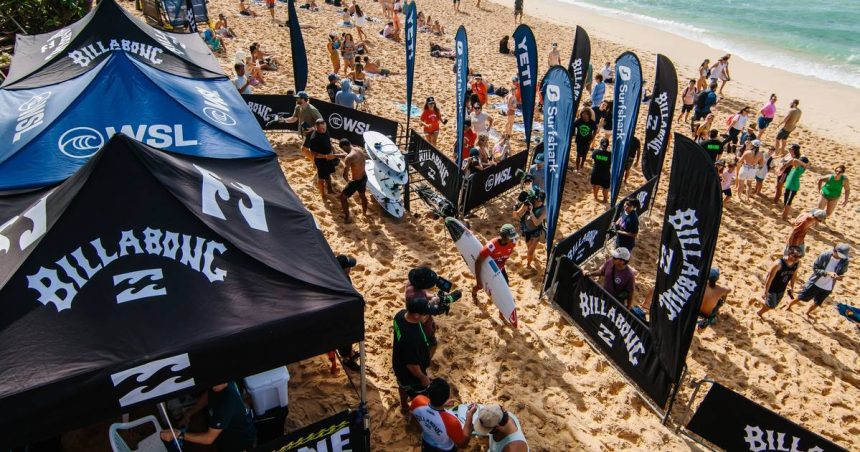How do brands sponsor a league that has no local teams, stadiums, or a robust US linear broadcast schedule? If you ask the World Surf League (WSL), it’s easier than it might sound.
“We are small, so we can be really innovative,” WSL CMO Sarah Swanson told Marketing Brew. “We are our own league, and we do control every aspect of it, so we can be really flexible, we can be really nimble, we can be really creative in a way that one of the largest sports definitely can’t.”
Surfing hasn’t quite broken into the mainstream in the US the way it has in countries like Brazil and Australia, Swanson said, but the WSL has nonetheless landed some major brand partners like Apple, Yeti, Billabong, Rip Curl, and Red Bull. In the coming years, the sport could stand to find further popularity as a result of its recent inclusion in the Olympics.
Marketing with the WSL is in some ways like marketing with other sports leagues, with options that include different tiers of sponsorships, athlete partnerships, and various forms of ad inventory. But there are some peculiarities, like the sport’s lack of stadium real estate and somewhat unpredictable schedules, which could mean rougher waters for some brands.
Sponsorships swell
Sponsorships make up the predominant revenue stream for the WSL, CRO Cherie Cohen told Marketing Brew, but the league also makes money from selling athlete memberships, tickets, merchandise, media rights, and other licensing deals. The WSL currently has close to 130 sponsors that include traditional surf brands and tourism boards around the world, since surfing and tourism often go hand in hand.
In addition to sponsorships, the WSL also sells traditional ad formats. WSL content, like full tournaments, highlights, and recaps, is mainly available on the league’s website and app, according to Swanson, and the league sells video and display ads that run against that content, Cohen said.
Some WSL programming is available via distributors like Roku and Amazon Fire TV, Swanson said, and distribution agreements let the league sell over-the-top inventory, Cohen said. It also streams live on YouTube, Facebook Watch, and TikTok, according to Swanson. The league has a first-look deal with YouTube, and the WSL sells pre-roll ads (and, soon, mid-roll) against content on its channel, Cohen said. Plus, the WSL has an ad-supported podcast.
While the league’s digital video presence is considerable, it’s harder to watch on broadcast TV. If you’re in Brazil or Australia, you can catch surfing on linear TV more easily than in the US, but generally speaking, “surfing is not particularly programmable,” Swanson said. Tournaments usually take place over about a 10-day timeframe, with the actual surfing happening over the course of around four days, though the exact days are at the mercy of Mother Nature. That setup means it can be “incredibly challenging” for linear partners, Swanson said.
Get marketing news you’ll actually want to read
The email newsletter guaranteed to bring you the latest stories shaping the marketing and advertising world, like only the Brew can.
“We’re a digital-first product because of the nature of the sport, and the linear piece tends to be more of our partners globally showing more of the highlights and recaps,” Swanson said.
The sport’s broad digital distribution helps the league make up for its relative lack of a linear footprint, and lets it offer geotargeting to “make sure our advertisers are getting what they need in the US,” Swanson said. Last year’s Championship Tour reached 46 million viewers across platforms, Cohen said, and the average event on the tour reaches about 10 million people—half through streaming and half through linear.
Shore thing?
Because the WSL produces its own broadcasts, the league has full control over when and where sponsors appear, Swanson said. Oftentimes, that’s through digital integrations, like brands appearing on the clock that counts down the heats, graphics that show surfing stats, and other on-screen moments similar to other sports, Cohen explained.
While there are no surfing stadiums, the WSL does install structures and signage on beaches where events take place when possible, Swanson said, and brands can also appear there.
Some prime surfing spots, like Tahiti, don’t have any beach space to spare, but most, like Brazil and LA, have plenty of room for brands to join in on the competition with real-life installations. As an example: The annual US Open of Surfing, which takes place in Huntington Beach, California, typically attracts 500,000 fans over nine days, according to Cohen, and brands can do giveaways or sell merch, according to Swanson. The league also offers pouring rights to its alcohol partners just like traditional stadiums do, Swanson said.
For title sponsors, Swanson said there’s the added marketing value of the brand awareness boost that can come with being attached to the name of a major surfing event that’s promoted year-round, like the Rip Curl WSL Finals.
As surfing continues to grow in popularity, more US advertisers might find the sport to be a new way to reach a broad audience.
“There is a lifestyle and an aspirational sense of brand around surfing that I think is incredibly appealing to people of all ages, all genders,” Swanson said. “With the Olympics—we are only going into our second time of being in the Olympics—the awareness in the US is growing very quickly and really dramatically, particularly as we go through this next summer’s Olympics and then moving into LA28. I think the trajectory for us is really strong.”
Read the full article here










